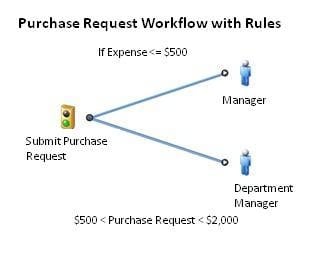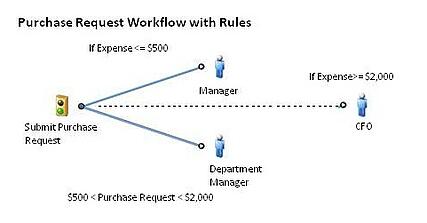Business processes can be very complex, having multiple, intertwined channels of workflow; some of which are used several times a day while others are only used once a quarter or year. When there is pressure to see results and ROI, taking the time to map out every single possible channel of workflow can actually hurt the overall success of the BPM project. This is where the "80/20 Rule" plays a role in process automation. By focusing on the processes that your organization uses the most, and that generates 80% of your revenue, your BPM project will be more successful than if you try to map them all out at once. Moreover, using Adaptive Discovery and rules, you can focus on the most common scenarios and outcomes.
For example, a manager for company X receives many purchase requests. If the request is under $500 he/she has the ability to approve it. However, if the request is for $500 to $2,000 the purchase request may need to be re-routed to the department manager or to the department manager's boss for approval. Typically for company X all of the purchase requests are under $2,000. This being said, company X automates their process, makes it "live" and applies rules that direct the request to the appropriate management level depending on the dollar amount.

Every now and then company X receives a purchase request for several thousand dollars. As there are no rules in company X's BPMS for a purchase request that exceeds $2,000 when a request of this size comes in the process owner will be notified. At this point, the process owner edits the rules in the BPMS to direct purchase requests of $2,000+ to the CFO or other executive member.

Based on the action taken with the large purchase request and the new rules applied, the BPMS "learns" what action should be taken in the future for similar requests.
By only mapping out the most typical scenarios (purchase requests under $500 and requests under $2,000) company X was able to launch their purchase request process quicker to start seeing time and cost savings with their BPMS. They essentially made their process "live" when it was only 70% complete, and through adaptive discovery they were able to more pieces to the puzzle when needed. This is one of the many benefits of a BPMS- you can always quickly and easily edit your processes to meet the changing needs of your company.
In starting your BPM project, don't panic if you can't think of all of the possible scenarios you may incur; rather model and automate the most common ones that are used on daily or weekly basis, and the rest will fall into place when they arise.
Relevant Links:
Methodology For Fast ROI with BPM: "Rome Was Not Built In A Day"
Think "Small" When Starting with BPM: Recipe for Immediate ROI
Strategies for Choosing Which Process To Automate: The Ultimus Process Prioritizer
Mary Katherine Strupe
Marketing Coordinator
Ultimus


